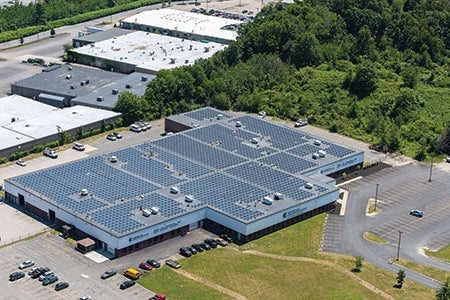New Mass. solar incentives to cut program costs $200M
 A solar installation covers the roof at 220 Brooks Street in Worcester.
A solar installation covers the roof at 220 Brooks Street in Worcester.
Solar energy traders would be about the only ones losing out under the Baker Administration's proposed new plan for incentivizing the solar industry, according to state officials who say the plan will benefit solar developers, solar investors and utility ratepayers.
Secretary of Energy and Environmental Affairs Matt Beaton told reporters Tuesday that the new solar incentive program would cut in half the roughly $400 to $500 million annual cost of solar incentives in the state while adding reliable revenue for developers and investors in solar projects.
"It kills two birds with one stone," Beaton said. He said Massachusetts has "the most lucrative incentive program in the nation," and the new system will provide fixed revenues and certainty that industry officials and investors desire going into a solar project.
Department of Energy Resources Commissioner Judith Judson said after regulatory processes within her department and at the Department of Public Utilities, the program should be in place by the end of the year. Judson is scheduled to present the plan on Tuesday at the Federal Reserve Bank of Boston.
The Baker administration also aims to ease the transition from solar renewable energy credits, or SRECs, to the new Solar Massachusetts Renewable Target, or SMART program. The proposed changes do not affect the state's net-metering program, which allows solar power producers to sell energy at above market value.
Under the SREC program, solar developers sell their credits at sometimes steep discounts to provide a stable source of revenue, Judson said.
"We can do the same thing for solar developers that this third-party financing is doing and then you immediately get all the savings. Ratepayers immediately get that savings," Judson said. She said, "We know there's some trading companies that are not happy with our new program, but they're not necessary to having successful solar and it's an added cost."
Under SMART, which is intended to incentivize the next 1,600 megawatts of solar energy development, a competitive procurement process would set a fixed price solar developers would receive for the first 200 megawatts of solar arrays under the program. As the price of electricity fluctuates, the incentive would rise and fall to keep the payment to the solar power producer steady.
Going forward from there, the fixed price would decline by 4 percent for each block of 200 megawatts within the program, according to officials. Last September, the Department of Energy Resources published a "straw proposal," similar in structure to the SMART program described Tuesday, with the price declining 5 percent for each 200 megawatt block.
On top of the fixed price, officials said Tuesday, solar developers would receive "adders," additional financial incentives for building solar on a landfill, brownfield, roof or canopy, or a "reducer" for building on unblemished open space.
Judson said the program aims to achieve the goals of reducing the cost of solar, land conservation, providing options for developers when the net-metering caps are hit, and an "orderly transition" from the SREC program.
The state has a mandate to reduce its greenhouse gas emissions to 25 percent below 1990 levels by 2020, and power generation is a big component of that, in addition to transportation emissions and energy efficiency.
Last April, Gov. Charlie Baker signed a law lifting net-metering caps and directing the energy department to come up with a solar incentive program for the future. In August Baker signed legislation directing utilities to procure 1,600 megawatts of offshore wind and about 1,200 megawatts of hydroelectric power.
Energy officials on Tuesday stressed the public outreach to stakeholders that preceded the SMART plan, and Judson said, "Developers are on board. The utilities are on-board."
As technology has improved and the industry has grown, costs have decreased. According to state officials citing the Solar Energy Industries Association, nationally the total cost of solar has declined 50 percent from five years ago.









0 Comments